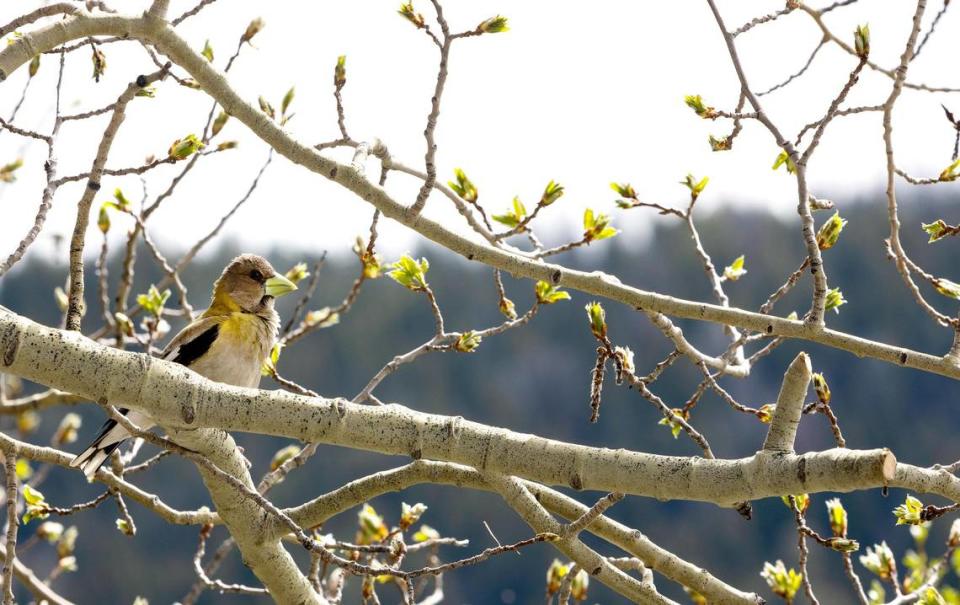Want to see wildlife in the Sawtooth National Recreation Area? Here are some tips
The Sawtooth National Recreation Area is a rugged Idaho wilderness full of gorgeous views as well as wildlife, from tiny birds and massive moose to predators like bears, wolves and elusive wolverines.
Whether you’re headed to the Sawtooths to camp, hike, backpack or just take in the scenery, there are ways to improve your chances of spotting wildlife, too. Here are a few tips:
▪ Know where to go: Many animals, including large mammals like elk, pronghorn and deer, can be seen from the road, Sawtooth National Recreation Area wildlife biologist Robin Garwood told the Idaho Statesman. She noted that pronghorn have been especially prevalent along highways in the Wood River Valley recently. Some animals, like bighorn sheep and predator species — including mountain lions and wolves — will be much more shy.
Garwood said the front of the Boulder mountain range, visible from Idaho 75, is a good area to scout for mountain goats. The Sawtooth National Recreation Area also has a designated mountain goat viewing area — aptly named Billy’s Bridge — that’s accessible from the same highway, about 18 miles north of Sun Valley. The site features informational signs and free binoculars.
Waterways can also be great spots to find wildlife. Look for massive sandhill cranes in marshy areas or along the Salmon River. Garwood suggested checking out some of the dozens of lakes in the recreation area during the spring and fall to spot less common species of waterfowl.

▪ Listen up: When you can’t see wildlife, you still may be able to hear it. Sandhill cranes have a loud, bugling call that can be heard for miles. In mountainous areas, you might hear the squeak or bark of a pica or marmot — rodent species that will call out to warn others of potential danger. During the fall rutting season, listen for the bugle of elk.
And, according to the Forest Service, some visitors hear wolves howling while they camp. Garwood said there are several packs whose territories are at least partially on the recreation area.
▪ Be an early bird: Many of the species on the SNRA are crepuscular, Garwood said, meaning they are most active in the twilight hours of the early morning and late evening. This can be a great time to plan your hike around or ensure you’re observing from a car or campground. Many bird species are most vocal at these times of day, as well.

▪ Make a list: Garwood told the Statesman there are a few hundred species of vertebrates — animals that have backbones, like mammals, birds, reptiles, amphibians and many fish — that call the Sawtooth National Recreation Area home. A checklist can help you keep track of which animals to see and introduce you to new species.
The recreation area has a list of bird species that is available online or at the area’s Forest Service offices. It shows which species are present in the area during each season, and how common each species is.
The Forest Service also has a webpage that breaks out wildlife by habitat. Headed to an alpine area? Keep an eye out for bighorn sheep and rosy finches. Hoping to see beavers? Riparian areas are the place to be.
Redfish Lake Lodge also has a list of species that are common near the lake.
▪ Behave yourself: Never intentionally disturb wildlife. Not only are you likely to ruin your own chances of seeing animals, you can harm wildlife, too — especially if you’re visiting in the winter when animals are doing their best to conserve energy and make it through the season.
Garwood said increased winter recreation coupled with habitat loss due to climate change is putting a squeeze on some species, like wolverines and mountain goats, who winter in deep snow.
“As more and more backcountry recreation occurs, which I’ve seen in my 30 years here, everyone is competing for the same areas,” Garwood said.
That’s not unique to the winter. Backcountry use in the summertime has surged, as well. Garwood said other activities, like rock climbing, can disturb nesting birds like peregrine falcons if climbers aren’t careful.

▪ Keep a safe distance: Give animals their space. The National Park Service’s requirements are a good rule of thumb — 25 yards from most wildlife and 100 yards from predators like bears and wolves. Never approach wolves or other predators when they’re on a kill, Garwood said.
“If you’re on a trail and you see a bear, the best thing is to give it a wide berth,” she added. “Don’t approach it.”
That advice goes for all animals.
“Typically an elk or a mountain goat isn’t going to charge you, but a moose will,” Garwood said. “Moose don’t like dogs (so) keep dogs under control.”

In many areas of the recreation area, dogs are required to be on-leash. They’re banned entirely from some sensitive areas, like the Goat Creek drainage. Check with the Forest Service before you arrive.
▪ Be bear aware: The Sawtooth National Recreation Area doesn’t have any documented grizzly populations (yet, Garwood noted — in recent years the bears have moved closer to central Idaho), but there is a healthy black bear population.
“The main (animal conflict) and the one that is most concerning is with bears,” Garwood said.
Between Memorial Day and Labor Day, the recreation area has a food storage order in place that requires campers and backpackers to store attractants (food, garbage, dirty dishes and scented items like toothpaste and deodorant) in a certified bear-resistant container or a hard-sided vehicle or building.

